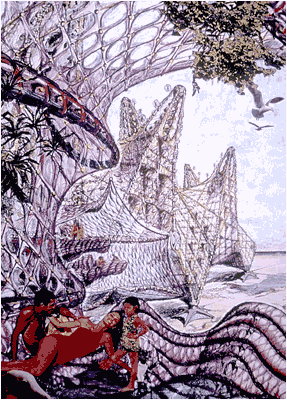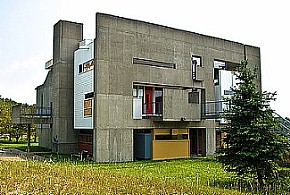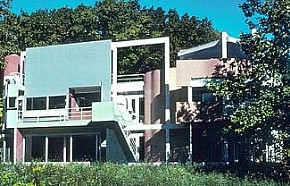2008.07.13 11:40
bored with modern & contemporary, yet?
Hint: Classical is high fertility and Gothic is early pregnancy.
Re:
1999.03.10
classical/modern
Hugh Pearman in two recent posts wrote:
"Architectural operating systems (as opposed to surface styling) are predominantly Gothic or Classical."
"What I called the 'architectural operating system' as a deliberate computer analogy -- might clarify rather than confuse, for me if nobody else."
I suggest a wholly other batch of "architectural operating systems" that derive from the morphology and physiology of our own bodies, the machines that we are instead of the machines that computers are.
Some architectures are extreme.
Some architectures are fertile.
Some architectures are pregnant.
Some architectures are assimilating.
Some architectures are metabolic.
Some architectures are osmotic.
Some architectures are electro-magnetic.
Some architectures are total frequency.
Figuring out what buildings/architects fit in which category(s) may well be the ultimate architectural parlor game. (hint: Classical is high fertility and Gothic is early pregnancy)
2008.07.09 18:24
Help on Wall label or object label in a museum
"The paradox is that architects work so hard at not working, sacrificing evenings, weekends, retirement, and even old age. The architect is a piece of equipment that is always on, with a screen saver of routine activities that represents action when nothing is happening. Every casual look when walking down the street or into a room is turned into an analytical, dissecting gaze."
--Wigley
You often find such topical caricatures of architects within the essays of Wigley from the last decade or so.
2008.07.09 18:01
The Power of Architecture
HA HA HA

| |
2008.07.06 19:16
architecture, technology, magic & war
You know, there actually were such things as "trade secrets". And maybe that's what the Great Pyramid really is, the world's largest manifestation of trade secrets.
2008.07.06 15:54
architecture, technology, magic & war
"Few texts concerning Egyptian engineering methods have survived the centuries, and in recent years experimental archaeology has been the main means for discovering the methods used for building the structure. Despite this, there are still many questions concerning the quarrying, dressing and transportation of the stone building blocks, let alone the methods by which they were placed meticulously in position. And there are further questions still about how the gigantic edifice was erected on a totally horizontal base, and aligned precisely with the stars.
"As the recent robotic explorations of the so-called air-shafts in the Great Pyramid have demonstrated, there is still a great deal that remains mysterious about the basic structure of pyramids, and the technology that created them.
www.bbc.co.uk/history/ancient/egyptians/great_pyramid_01.shtml
2008.07.06 11:15
How "futuristic" really is SCI_arc?
Is there a way to photoshop not by HAND?
Drawing and collaging by WORD OF MOUTH, now that's futuristic!
2008.07.05 18:21
How "futuristic" really is SCI_arc?
That's right. The future's exactly what it's gonna be.
2008.07.05 17:46
How "futuristic" really is SCI_arc?

There's nothing like the good old-fashioned future.
| |
2008.07.05 12:46
architecture, technology, magic & war
Almost all built architecture today is manifest within a regulated industry. And the regulations deal mostly with issues of safety and with issues of money (not necessarily in that order).
Visionary architecture is first manifest virtually, and sometimes, rarely even, passes through the regulations into built form.
Design/build a robot that will manifest a paradigm shift?
2008.07.05 11:44
architecture, technology, magic & war
The point of the great pyramids today is exactly that they make no sense; we don't even know how they were built. And, unless you believe in magic, the pyramid builders used a 'technology' that is somehow beyond us right now.
Just kill the notion of "how things were always done" because that's the real myth of your argument. "How things are done" has always been a very non-homogeneous set of situations. If you look closely, computers have (already) greatly enabled an even more vast proliferation of non-homogeneous ways of doing things.
There is a detectable magic in true non-homogeneous visionariness.
Historiography is now paradoxically caught up with writing predictions of the future, and that's because a true (magical) historian actually can simultaneously write about past, present and future events.
2008.07.05 10:50
architecture, technology, magic & war
How did they build those great pyramids? Perhaps the (only natural?) 'flipping' of the planet's electro-magnetic field resulting in a brief lessening of gravitational force opened a magical window of architectural opportunity.
Is it true that the smallest of the four great pyramids is composed entirely of brick?
2008.07.05 10:27
Can you say canonical?
...read the 'Introduction' and be aware of Eisenman's ongoing oppositional reenactment of Colin Rowe's analytical method (which ultimately reaches farce in the analysis of the 10th canonical building).
One could almost describe Eisenman's whole architectural design career as one oppositional reenactment after another, finally puctuated with bursts of intense originality (like the Max Reinhardt Haus, Haus Immendorf and the Staten Island Institute of Arts and Sciences).
2008.07.05 10:12
Featured Discussion: Volume
Got a bunch of Volumes and a bunch of Logs recently. Overall, I like the Logs better.
2008.07.05 10:05
architecture, technology, magic & war
It is indeed fortunate that white magic as a viable operating system is so denegrated today. True to form, however, white magic can be nothing but rare. As rare even as the human who admits the source of their own moments of white magic receivership.
Look at what architectures are globally coeval with Gothic while researching the 2nd and 3rd months of embryonic development to get a fuller picture of that time.
Black magic is a forever abundant fabrication.
Many "technologies of the past" are still in use today, especially in architecture.
| |
2008.06.30 15:58
Can you say canonical?
Close reading really shouldn't manifest intellectual property issues.
"We understand Le Corbusier's Palais des Congrès in Strasbourg as canonical today primarily because it has sponsored several generations of work on the warped surface. In this case, Koolhaas's Jussieu Libraries confer a retrospective "canonical" status to this previously somewhat overlooked building."
--Stan Allen, 2008
Quondam, 2000.05.06
2008.06.30 15:24
the miller house (should be more famous)
"Ah, Detailotheca, the nimiety of detail museum."
"If only all architecture were so self-evident."
"I know. It never really was a house, was it?"
"True, but it's actually two museums."
"Ah yes, the Reenactment of Late Le Corbusier Style Museum as well."
2008.06.28 09:21
the miller house (should be more famous)
 Looks like late Le Corbusier style as Composite Order--Villa Shodham meets Heidi Weber Pavilion meets Chandigarh tapestries.
Looks like late Le Corbusier style as Composite Order--Villa Shodham meets Heidi Weber Pavilion meets Chandigarh tapestries.
What was the year of construction?
Evokes some memories of Graves' Snyderman House.

| |
2008.06.28 08:47
Can you say canonical?
"...does there have to be ten buildings?"
A close reading of Ten Canonical Buildings: 1950-2000 very much discloses a sublimated implicit nth canonical building, videlicet Quondam, a virtual museum of architecture: 1996-.
The stars of Ten Canonical Buildings: 1950-2000, somewhat ironically, are not actual buildings at all, viz. the Palais des Congrès-Strasbourg (1962-64) and the Jessieu Libraries (1992-93). In the Forward, Stan Allen refers to the Palais des Congrès as a "previously somewhat overlooked building." As it happened, Arcadia's 1991 published analysis of the Palais des Congrès became one of the corner stones of Quondam. Was Koolhaas aware of Arcadia's analysis within the Loeb Library at Harvard?
In a geometrically progressive sense, Eisenman describes canonical buildings as designs which themselves manifest a close reading. Albeit requiring a 'photo-finish', Stirling wins the "architect as close reader" award, with many close seconds. Stirling perfected the reenactionary architecturism kick.
While reading/skimming through Ten Canonical Buildings: 1950-2000, I often wish Koolhaas was the author rather than Eisenman (although Eisenman does indeed set a fine stage himself), but, alas, Koolhaas has already designed another nth canonical building, viz. OMA's Patent Office:
"Social Condenser" (1982)
"Strategy of the Void I" (Planning) (1987)
"Timed Erasures" (1991)
"Loop-Trick" (1987)
"Strategy of the Void II" (Building) (1989)
"Stacked Freedoms" (1989)
"Inside-Out City" (1993)
"Disconnect" (1994)
"Everywhere and Nowhere" (1994)
"Variable Speed Museum" (1995)
"Inertness Modified" (1997)
Tall & Slender (1996)
Skyscraper Loop (2002)
"Cake-tin Architecture" (2002)
"The End of the Road" (2003)
In 1972, the Musical Heritage Society offered a free recording of Pachelbel's Canon in D Major as performed by the Jean-François Paillard chamber orchestra when you(I) joined their record club. By the late 1970's, Pachelbel's Canon became very popular. Perhaps canons are best when consummately baroque.
Read a novel while enjoying the Schlittenfahrt.
2008.06.26 08:05
Can you say canonical?
Odd dyslexical, editorial mistakes on pages 88 and 89 (etc.):
On page 88, the fifth floor is depicted, yet it is labeled and analyzed as if it were the fourth floor.
Likewise, on page 89, the fourth floor is depicted, yet it is labeled and analyzed as if it were the fifth floor.
The mistake is carried through on page 91 where "...the fulcrum for the spiraling movement in the second, third and fourth floors." should actually read "second, third and fifth floors."
Additionally, what is 'interpreted' as a central stair core of the building, is actually a stacked pair of up and down escalators. The stair "core" of the building is someplace else.
And it is unfortunate that the stage set is missed altogether within the 'canonical' analysis, as it would have offered the 'missing link' of clarity to the whole figure/grid development.
Hejduk, wo bist du?
In the Introduction, Eisenman emphasizes the notion of "close reading", yet, with the series of mistakes within (at least) the Palais des Congrès analysis, I have to wonder just how closely Eisenman actually "read" these buildings and how much was simply relied upon the student analyses that the book is based on.
|